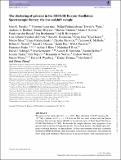The clustering of galaxies in the SDSS-III Baryon Oscillation Spectroscopic Survey : the low-redshift sample
Abstract
We report on the small-scale (0.5 <r <40 h-1 Mpc)clustering of 78 895 massive (M* ˜ 1011.3M⊙) galaxies at 0.2 <z <0.4 from the first twoyears of data from the Baryon Oscillation Spectroscopic Survey (BOSS),to be released as part of Sloan Digital Sky Survey (SDSS) Data Release 9(DR9). We describe the sample selection, basic properties of thegalaxies and caveats for working with the data. We calculate the real-and redshift-space two-point correlation functions of these galaxies,fit these measurements using halo occupation distribution (HOD)modelling within dark matter cosmological simulations, and estimate theerrors using mock catalogues. These galaxies lie in massive haloes, witha mean halo mass of 5.2 × 1013 h-1M⊙, a large-scale bias of ˜2.0 and a satellitefraction of 12 ± 2 per cent. Thus, these galaxies occupy haloeswith average masses in between those of the higher redshift BOSS CMASSsample and the original SDSS I/II luminous red galaxy sample.We report on the small-scale (0.5 < r < 40 h−1 Mpc) clustering of 78 895 massive (M* ∼ 1011.3 M⊙) galaxies at 0.2 < z < 0.4 from the first two years of data from the Baryon Oscillation Spectroscopic Survey (BOSS), to be released as part of Sloan Digital Sky Survey (SDSS) Data Release 9 (DR9). We describe the sample selection, basic properties of the galaxies and caveats for working with the data. We calculate the real- and redshift-space two-point correlation functions of these galaxies, fit these measurements using halo occupation distribution (HOD) modelling within dark matter cosmological simulations, and estimate the errors using mock catalogues. These galaxies lie in massive haloes, with a mean halo mass of 5.2 × 1013 h−1 M⊙, a large-scale bias of ∼2.0 and a satellite fraction of 12 ± 2 per cent. Thus, these galaxies occupy haloes with average masses in between those of the higher redshift BOSS CMASS sample and the original SDSS I/II luminous red galaxy sample.
Citation
Parejko , J K , Sunayama , T , Padmanabhan , N , Wake , D A , Berlind , A A , Bizyaev , D , Blanton , M , Bolton , A S , van den Bosch , F , Brinkmann , J , Brownstein , J R , da Costa , L A N , Eisenstein , D J , Guo , H , Kazin , E , Maia , M , Malanushenko , E , Maraston , C , McBride , C K , Nichol , R C , Oravetz , D J , Pan , K , Percival , W J , Prada , F , Ross , A J , Ross , N P , Schlegel , D J , Schneider , D , Simmons , A E , Skibba , R , Tinker , J , Tojeiro , R , Weaver , B A , Wetzel , A , White , M , Weinberg , D H , Thomas , D , Zehavi , I & Zheng , Z 2013 , ' The clustering of galaxies in the SDSS-III Baryon Oscillation Spectroscopic Survey : the low-redshift sample ' , Monthly Notices of the Royal Astronomical Society , vol. 429 , no. 1 , pp. 98-112 . https://doi.org/10.1093/mnras/sts314
Publication
Monthly Notices of the Royal Astronomical Society
Status
Peer reviewed
ISSN
0035-8711Type
Journal article
Collections
Items in the St Andrews Research Repository are protected by copyright, with all rights reserved, unless otherwise indicated.

